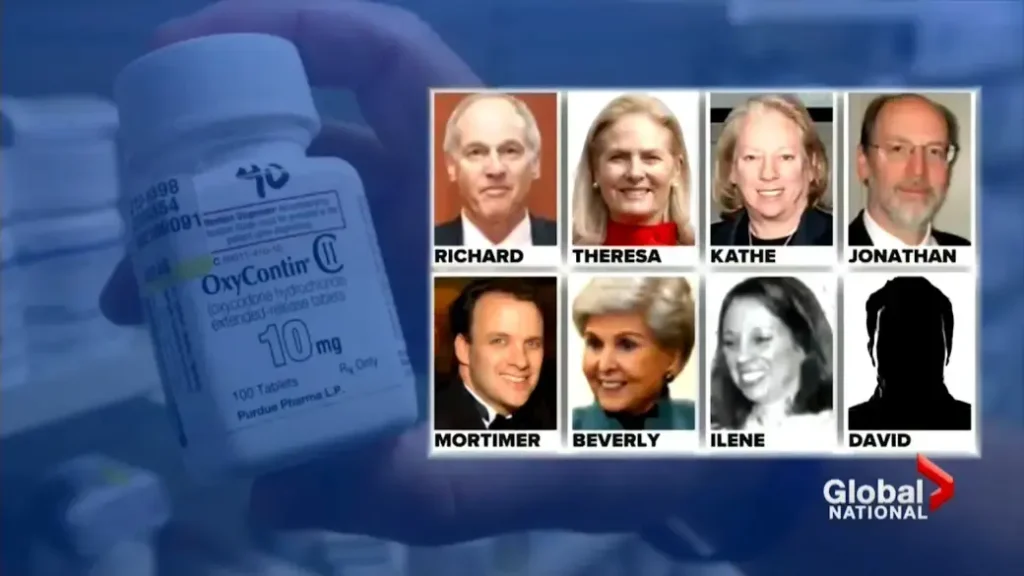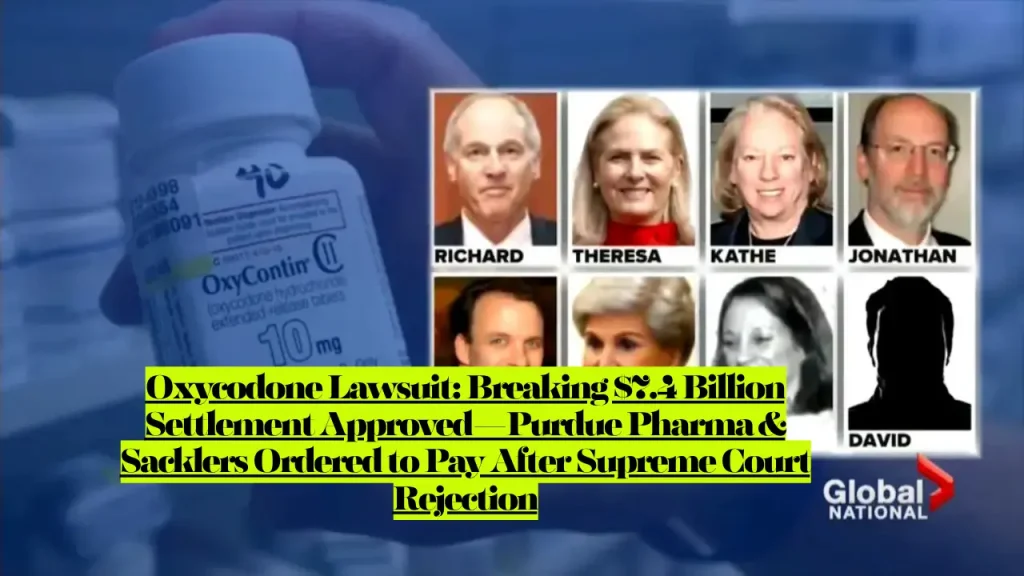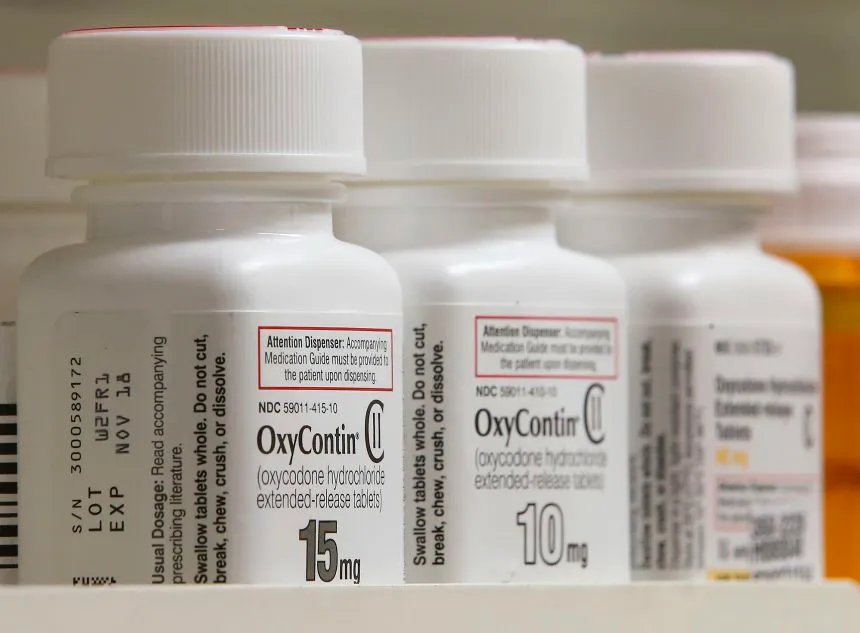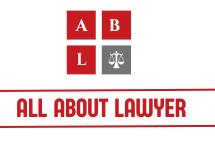Oxycodone Lawsuit, $7.4 Billion Settlement Approved—Purdue Pharma Who Make OxyContin & Sacklers Ordered to Pay After Supreme Court Rejection
A federal bankruptcy judge approved a one of great $7.4 billion settlement on November 14, 2025, requiring Purdue Pharma and the Sackler family to pay for their role in the opioid crisis. The agreement, reached in January 2025 after the Supreme Court rejected a prior $6 billion settlement in June 2024, represents the nation’s largest opioid settlement with individuals held accountable for fueling the prescription painkiller epidemic.
The Sacklers will pay up to $6.5 billion while Purdue contributes $900 million, with $850 million specifically allocated to individual victims—a rare feature in pharmaceutical settlements. This resolution ends years of litigation over OxyContin, the oxycodone-based painkiller that sparked America’s deadly addiction crisis.
What Is the Oxycodone Lawsuit About?
The oxycodone lawsuit centers on Purdue Pharma’s marketing of OxyContin between 1996 and the late 2010s, which state and local governments argue fueled the initial wave of the opioid crisis from 1999 to 2010. Thousands of lawsuits alleged the company targeted doctors with misleading messages that addiction risk was low.
Purdue filed for Chapter 11 bankruptcy in 2019 as it faced claims totaling trillions of dollars from state and local governments, individuals, and federal authorities. The litigation encompasses product liability claims, fraudulent marketing allegations, failure to warn about addiction risks, and controlled substances violations.
Legal Claims in the Oxycodone Litigation
The lawsuits against Purdue and oxycodone distributors involve multiple legal theories:
Product Liability & Defective Design Plaintiffs alleged oxycodone products were defectively designed because manufacturers failed to include safety mechanisms such as antagonist agents or tamper-resistant formulations.
Failure to Warn Manufacturers purportedly failed to adequately warn about addiction risks on drug packaging and in promotional activities, with some claims alleging companies deliberately withheld information about dangers and misrepresented products as safer than alternatives.
Fraudulent Marketing A 2007 federal settlement revealed Purdue Frederick Company pled guilty to fraudulently marketing OxyContin by falsely claiming it was less addictive and less subject to abuse when no medical research supported these claims.
Controlled Substances Act Violations Distributors faced allegations they failed to maintain effective controls against suspicious opioid orders and notify the Drug Enforcement Administration of potentially illegitimate orders as required by federal law.
Public Nuisance Claims Government plaintiffs argued Purdue and Sackler family members created a public nuisance, though defendants maintain this legal theory is devoid of merit.

Who Are the Parties in the Lawsuit?
Defendants:
- Purdue Pharma L.P. (OxyContin manufacturer)
- Members of the Sackler family (company owners)
- The family made more than $35 billion from OxyContin distribution
Plaintiffs:
- State attorneys general from all 50 states
- Thousands of local governments and counties
- Native American tribal governments
- Individual victims and families affected by oxycodone addiction
- Federal government agencies
Breaking: Supreme Court Rejection Leads to New Deal
In June 2024, the U.S. Supreme Court ruled 5-4 in Harrington v. Purdue Pharma L.P. that the bankruptcy code does not authorize releases that discharge claims against non-debtors without affected creditors’ consent, blocking the original settlement’s liability shield for the Sackler family.
The rejection forced parties back to negotiations. On January 23, 2025, a coalition of 15 states announced an agreement in principle with Purdue requiring the company and Sackler family to pay $7.4 billion.
Key differences from the rejected settlement:
- Increased payment: Up from $6 billion to $7.4 billion
- Limited immunity: The new agreement protects family members from lawsuits only from entities that agree to the settlement, not universal immunity
- Faster payout: Individual victim funds delivered in 2026
- Stronger accountability measures: The Sacklers’ control of Purdue Pharma ends and they are restricted from selling opioids in the United States
Current Case Status & Court Approval
U.S. Bankruptcy Judge Sean Lane formally approved the settlement on November 14, 2025, after overwhelming victim support with only 218 of 54,000 personal injury victims voting against acceptance.
The settlement includes:
- $6.5 billion from Sackler family members paid over 15 years
- $900 million from Purdue Pharma upon bankruptcy emergence
- $850 million set aside for individual victims, with over $100 million carved out for children born dealing with opioid withdrawal
- Up to $800 million reserved for future settlements if new lawsuits arise against the Sacklers
- Public release of company documents, including attorney-client privileged materials
Purdue Pharma’s lobbying and marketing efforts will be limited and monitored as part of the settlement.
What Compensation Is Available for Victims?
Individual victims or families can receive payments ranging from approximately $3,500 to $48,000, based on factors like length of opioid use, addiction severity, overdose incidents, and death caused by opioids.
Eligibility Requirements: Claimants must prove prescription of Purdue-branded OxyContin through medical records, prescription documentation, or pharmacy records. Some individuals may obtain prescription records through state Prescription Monitoring Programs.
Payment Challenges: Many victims struggle to obtain medical records from shuttered doctors’ offices or pharmacies that didn’t retain older documents. Out of nearly 20,000 people who contacted one law firm, only about 3,500 were able to file claims.
Other Opioid Settlements: Mallinckrodt, a generic opioid manufacturer, began paying victims in early 2025, with some receiving between $400 and $700 after administrative and attorney fees.
How the Oxycodone Lawsuit Compares to Other Pharmaceutical Cases
The $7.4 billion Purdue settlement ranks among the largest pharmaceutical litigation resolutions in U.S. history:
- McKinsey & Company: $650 million settlement in December 2024 for helping Purdue boost OxyContin sales
- Johnson & Johnson: $149.5 million to Washington state for manufacturing and supplying raw opioid ingredients
- Publicis Health: $350 million settlement in February 2024 for falsely marketing opioids as safe on behalf of Purdue
- Cardinal Health & McKesson: Multiple settlements totaling hundreds of millions for failing to report suspicious opioid orders
National opioid settlements across all defendants now exceed $50 billion, with most funds required to be used for crisis abatement.
Timeline of Key Oxycodone Lawsuit Events
1996: Purdue Pharma launches OxyContin Early 2000s: First personal injury lawsuits filed against Purdue 2007: Purdue Frederick Company pays $634.5 million and pleads guilty to fraudulent marketing 2017: Wave of thousands of lawsuits begins from state and local governments 2019: Purdue Pharma files for Chapter 11 bankruptcy 2021: Initial bankruptcy reorganization plan proposed June 2024: Supreme Court rejects $6 billion settlement in Harrington v. Purdue Pharma L.P. January 23, 2025: Coalition of 15 states announces $7.4 billion agreement in principle November 14, 2025: Federal bankruptcy judge approves final settlement
What Does This Mean for the Pharmaceutical Industry?
The oxycodone settlement establishes significant precedent for corporate accountability in public health crises.
Industry Impact:
- Stricter marketing oversight for controlled substances
- Enhanced monitoring of suspicious order patterns
- Greater scrutiny of pharmaceutical family ownership structures
- Potential for similar litigation against other opioid manufacturers
The settlement ends the Sacklers’ control of Purdue and their ability to sell opioids anywhere in the world. Family members are barred from having their names added to institutions in exchange for charitable contributions.
What Are the Next Steps?
For Individual Victims: All money for individual victims will be delivered in 2026. Eligible claimants should gather documentation of Purdue-branded OxyContin prescriptions.
For Governments: Utah expects to receive $57 million, with the Sackler family paying over 15 years and Purdue contributing $900 million when emerging from bankruptcy.
Ongoing Litigation: Entities that don’t opt into the settlement retain the right to sue Sackler family members, though much of their wealth is in offshore accounts that might be impossible to access through lawsuits.
Related Cases: Depo-Provera lawsuits continue over brain tumor allegations. Class action settlements against other pharmaceutical companies proceed separately.

Am I Eligible to File an Oxycodone Claim?
You may be eligible if you:
- Were prescribed Purdue-branded OxyContin (not generic oxycodone)
- Developed opioid addiction or suffered overdose
- Lost a family member to opioid-related death
- Can provide documentation through medical records, prescriptions, or pharmacy records
The deadline for submitting personal injury claims to the Mallinckrodt Personal Injury Trust is June 15, 2025. Check specific settlement deadlines as they vary by defendant.
Individuals can submit claims without attorneys, though some choose legal representation for complex cases.
FAQs About the Oxycodone Lawsuit
What is the oxycodone lawsuit about?
The litigation involves thousands of lawsuits against Purdue Pharma, the Sackler family, and oxycodone distributors for allegedly fueling the opioid crisis through fraudulent marketing, failure to warn about addiction risks, and violations of controlled substances laws.
What is the latest update on the oxycodone lawsuit?
On November 14, 2025, a federal bankruptcy judge approved a $7.4 billion settlement requiring Purdue Pharma and the Sackler family to pay state and local governments and individual victims.
How much compensation can I get from the oxycodone settlement?
Individual victims can receive between $3,500 and $48,000 depending on factors like addiction severity, overdose incidents, and whether death occurred. Payments will be distributed in 2026.
Is there a deadline to file an oxycodone lawsuit claim?
Deadlines vary by settlement. Some individual trusts have June 2025 deadlines, while the Purdue settlement distributes funds in 2026. Contact an attorney immediately to avoid missing eligibility windows.
Who is eligible for the oxycodone settlement?
Eligibility requires proof of Purdue-branded OxyContin prescription (not generic oxycodone) and resulting harm such as addiction, overdose, or death. Medical records, prescription documentation, or pharmacy records serve as proof.
What legal claims were involved in the oxycodone lawsuit?
Claims include product liability (defective design), failure to warn, fraudulent marketing, Controlled Substances Act violations, public nuisance, and unjust enrichment.
How long will the oxycodone lawsuit take?
The main Purdue settlement received court approval in November 2025 after six years of bankruptcy proceedings. Individual payments begin in 2026, with Sackler family payments continuing over 15 years.
Understanding Pharmaceutical Liability in Opioid Cases
The oxycodone litigation demonstrates how courts apply product liability principles to prescription medications. Drug manufacturers have a legal responsibility to ensure medications carry adequate warnings and are safe to use.
Burden of Proof: Plaintiffs must prove the drug company’s actions hurt their clients by demonstrating: (1) the company misled the public about risks, (2) certain risks existed but weren’t disclosed, and (3) the manufacturer failed to warn healthcare providers about addictive nature.
Government Claims Advantages: Government lawsuits avoid defenses blaming opioid consumers or prescribers because the government itself claims injury and seeks restitution to repair social systems debilitated by addiction.

The Public Health Impact
Opioid-involved deaths increased in waves since 1999, with the initial wave attributable to misuse and diversion of prescription opioids like OxyContin, followed by heroin and illicit fentanyl waves.
While 2023 saw the first annual decrease in opioid deaths since 2018, the toll remains devastating. More than 180,000 Americans died from opioid overdoses between 2000 and the settlement negotiations.
Where Settlement Funds Go: State and local governments must use settlement payments for:
- Substance use prevention programs
- Addiction treatment services
- Recovery support
- Overdose prevention initiatives
- Prescription monitoring programs
For related pharmaceutical litigation, see medical device lawsuits and other class action settlements.
Additional Resources
- National Opioid Settlement tracker
- State attorney general opioid litigation pages
- U.S. Bankruptcy Court Southern District of New York (Purdue case docket)
- Substance Abuse and Mental Health Services Administration (SAMHSA)
Disclaimer: This information is for educational purposes only and does not constitute legal advice. Lawsuit details, case status, and settlement information may change. Consult official court records, review current case filings independently, and contact an attorney for specific questions about oxycodone lawsuits or legal rights. Settlement eligibility and compensation amounts should be verified through official settlement administrators and legal counsel.
About the Author

Sarah Klein, JD, is a licensed attorney and legal content strategist with over 12 years of experience across civil, criminal, family, and regulatory law. At All About Lawyer, she covers a wide range of legal topics — from high-profile lawsuits and courtroom stories to state traffic laws and everyday legal questions — all with a focus on accuracy, clarity, and public understanding.
Her writing blends real legal insight with plain-English explanations, helping readers stay informed and legally aware.
Read more about Sarah
